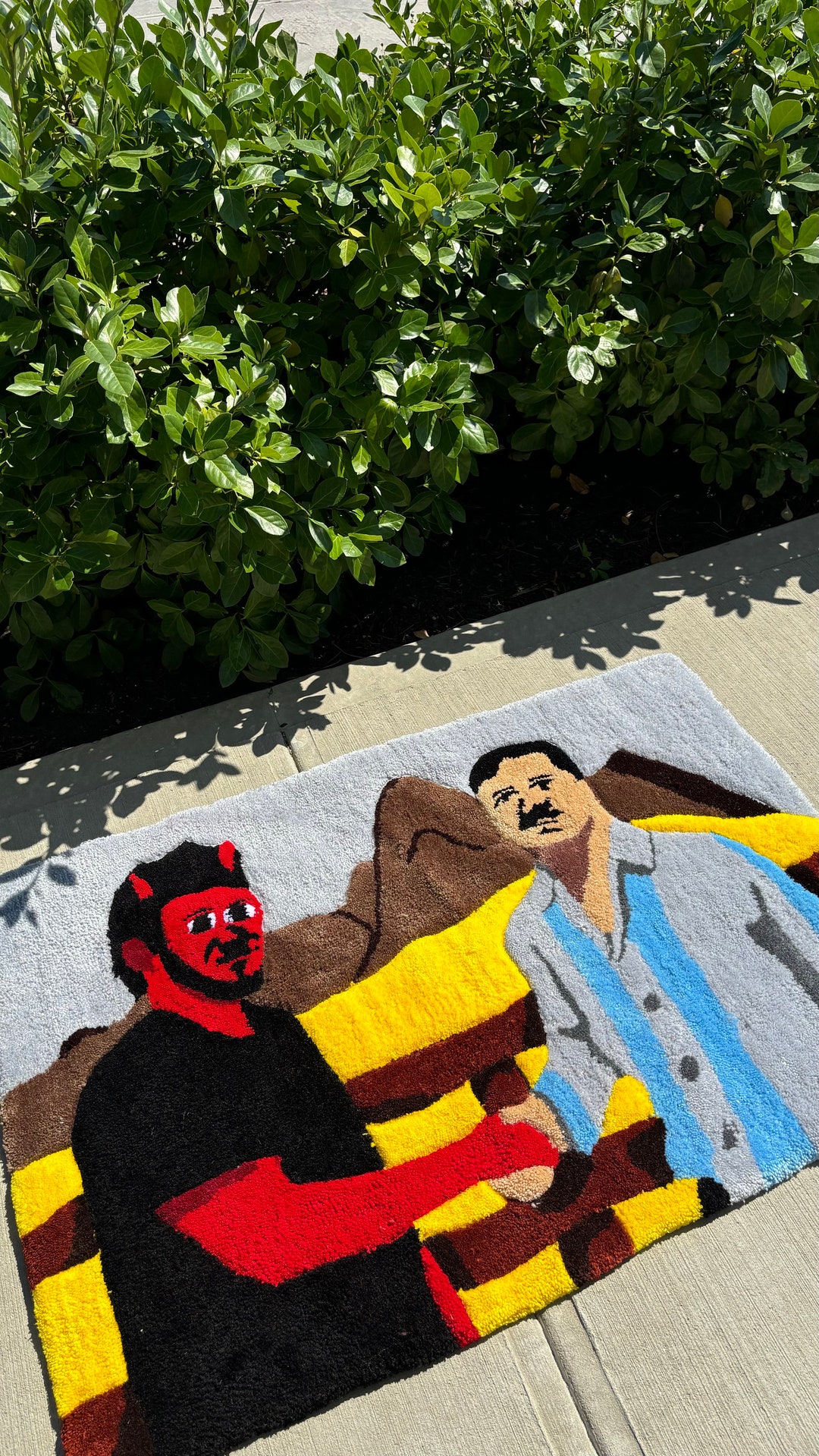The name Joaquín "El Chapo" Guzmán evokes images of a shadowy underworld, audacious escapes, and immense power. But what if we told you that understanding his saga is like unraveling an "El Chapo rug"—a complex tapestry with hidden layers, intricate designs, and startling revelations concealed beneath the surface? This metaphorical "rug" represents the unseen forces, the meticulously planned operations, and the astonishing events that defined the life of one of the world's most notorious drug lords.
From his humble beginnings to becoming the undisputed leader of the Sinaloa Cartel, El Chapo's story is a testament to both cunning and brutality. His legendary escapes from maximum-security prisons, often involving elaborate tunnels and secret compartments, serve as vivid examples of these hidden layers. Join us as we pull back the metaphorical "El Chapo rug" to explore the life, crimes, and ultimate downfall of a man whose legend continues to fascinate and horrify.
Biography of Joaquín "El Chapo" Guzmán
Joaquín Archivaldo Guzmán Loera, better known by his infamous alias "El Chapo," is a name synonymous with global drug trafficking. Born on April 4, 1957, in La Tuna, Badiraguato, Sinaloa, Mexico, Guzmán's early life was marked by poverty and a lack of formal education. He entered the drug trade in the late 1970s, initially working for other cartels before eventually founding his own empire.
His rise to power was swift and brutal, characterized by strategic alliances, ruthless elimination of rivals, and an unparalleled ability to move massive quantities of illicit drugs, particularly cocaine, marijuana, methamphetamine, and heroin, into the United States. By 2003, after the arrest of his rival Osiel Cárdenas of the Gulf Cartel, El Chapo had cemented his position as Mexico's top drug lord, a title he would hold for years, making him one of the most powerful and feared figures in organized crime history.
Personal Data & Biodata
To provide a clearer picture of the man behind the legend, here is a summary of Joaquín "El Chapo" Guzmán's personal data:
| Attribute | Detail |
|---|---|
| Full Name | Joaquín Archivaldo Guzmán Loera |
| Aliases | El Chapo, El Rápido |
| Date of Birth | April 4, 1957 |
| Place of Birth | La Tuna, Badiraguato, Sinaloa, Mexico |
| Nationality | Mexican |
| Height | 5 feet 6 inches (approx. 168 cm) |
| Occupation | Former Leader of the Sinaloa Cartel |
| Known For | Drug Trafficking, Multiple Prison Escapes |
| Current Status | Imprisoned in the United States |
From Humble Beginnings to Drug Lord
Guzmán's journey from a remote, impoverished village to becoming one of the wealthiest and most wanted criminals in the world is a narrative often romanticized, yet it is rooted in the brutal realities of the drug trade. He began cultivating marijuana and opium poppies as a child to support his family. His ambition and strategic mind quickly set him apart. He forged crucial connections, learning the intricacies of drug distribution and logistics. His ability to transport drugs swiftly and efficiently earned him the nickname "El Rápido." This early success laid the groundwork for the vast criminal enterprise that would eventually become the Sinaloa Cartel, an organization that, under his leadership, would control a significant portion of the global illicit drug market.
The Art of Escapology: Unearthing the El Chapo Rug
Perhaps no aspect of El Chapo's life captured public attention more than his astonishing ability to escape from high-security prisons. These escapes were not mere breaks but meticulously planned operations, often involving significant resources and insider corruption, truly embodying the concept of an "El Chapo rug" – a grand illusion concealing a hidden path to freedom.
The 2001 Escape: A First Glimpse Beneath the Rug
El Chapo's first major escape occurred in 2001. He had been captured in 1993 in Guatemala and subsequently sentenced to 20 years in a Mexican maximum-security prison. However, on January 19, 2001, he managed to escape, reportedly by bribing prison guards and hiding in a laundry cart. This escape allowed him to rebuild and consolidate his power, laying the groundwork for the cartel's expansion and his legendary status. It was the first time the world truly saw the hidden mechanisms at play beneath the surface of his incarceration, a subtle hint of the complex "El Chapo rug" that would later be fully revealed.
The Infamous 2015 Tunnel: The Ultimate El Chapo Rug
The second escape, on the evening of July 11, 2015, was a feat of engineering and audacity that cemented his mythical status. From his cell in Altiplano, Mexico's most secure prison, Joaquín "El Chapo" Guzmán simply walked behind his cell's shower divider and slipped through a hole in the floor. This hole led to a mile-long tunnel, complete with lighting, ventilation, and even a motorcycle on rails, which exited into a construction site outside the prison walls. Caked in filth, the world's most powerful drug baron hauled himself from a manhole, vanishing into the night.
This escape was the ultimate manifestation of the "El Chapo rug." It wasn't just a simple hole; it was an elaborate, sophisticated network hidden from plain sight, meticulously planned and executed over months, if not years. The tunnel, dug by the Sinaloa Cartel, demonstrated an incredible level of resources, technical expertise, and corruption within the prison system. It showcased Guzmán's unparalleled "feats of escapology," proving that even behind bars, he could orchestrate a grand disappearing act, pulling the rug out from under the very authorities trying to contain him.
The Name Behind the Legend: Understanding "El" and "Él"
The alias "El Chapo" is widely recognized, but the word "El" itself has a fascinating linguistic background, often confused with "Él" in Spanish. Understanding this distinction helps in appreciating the nuances of his infamous moniker.
In Spanish, "El" without an accent mark is a definite article, meaning "the." It is typically placed before concrete singular masculine nouns. For example, "el hombre" means "the man." On the other hand, "Él" with an accent mark on the 'é' is a subject personal pronoun, directly translating to "he." For instance, "Él tiene muchos amigos" means "He has lots of friends."
Joaquín Guzmán's alias, "El Chapo," uses "El" as the definite article, meaning "The Shorty." This nickname refers to his relatively short stature, standing at 5 feet 6 inches. The use of "El" here is consistent with how Spanish nicknames are often formed, emphasizing a particular characteristic. This small linguistic detail, often overlooked, is part of the broader tapestry of the "El Chapo rug," adding a layer of cultural context to his identity.
Interestingly, the word "El" also has ancient roots. It is a Northwest Semitic word meaning 'god' or 'deity', or referring (as a proper name) to any one of multiple major ancient Near Eastern deities. A rarer form, 'ila, represents the predicate. While unrelated to Guzmán's nickname, it highlights the deep historical and linguistic significance of the word itself, adding another layer to the name's inherent power and mystique, albeit in a completely different context.
The Sinaloa Cartel: Weaving a Web of Power
The Sinaloa Cartel, under Joaquín "El Chapo" Guzmán's leadership, became one of the most powerful and sophisticated organized crime groups in the world. His ability to simultaneously control vast drug trafficking networks while evading capture for years was unparalleled. The cartel's operations spanned continents, moving cocaine, heroin, marijuana, and methamphetamine through intricate supply chains into the United States and beyond.
The cartel's success was built on a combination of violence, corruption, and strategic business acumen. They established complex logistics, including tunnels under the U.S.-Mexico border, maritime routes, and air shipments, to ensure the uninterrupted flow of drugs. This vast network, often operating beneath the radar of international law enforcement, was another form of the "El Chapo rug"—a vast, hidden infrastructure that supported his criminal empire. His influence was so profound that in 2012, the city of Chicago even named Joaquín Guzmán "Public Enemy No. 1," a title previously held only by Al Capone, highlighting the global reach and impact of his criminal enterprise.
The Pursuit and Recapture: Lifting the El Chapo Rug
Despite his legendary escapes and elusive nature, the pursuit of Joaquín "El Chapo" Guzmán was relentless. After his audacious 2015 escape, Mexican and U.S. authorities launched a massive manhunt. The pressure mounted, and the intelligence gathering intensified. This period saw a concerted effort to lift the "El Chapo rug" and expose his hiding places and support networks.
His recapture was announced on January 8, 2016, in Los Mochis, Sinaloa, Mexico, following a fierce shootout. Reports suggest that the advanced use of surveillance systems, including the NSO system, along with other intelligence measures, played a crucial role in locating him. This time, the authorities were determined to ensure there would be no third escape. The recapture marked a significant victory for law enforcement, demonstrating that even the most elusive figures could eventually be brought to justice. It was a moment when the hidden layers of the "El Chapo rug" were finally peeled back, revealing the man beneath the myth.
The Trial of the Century: Unfolding the El Chapo Rug in Court
Following his recapture, Joaquín "El Chapo" Guzmán was extradited to the United States in January 2017 to face a federal criminal court case against Joaquín Guzmán Loera in Brooklyn, New York. This trial, United States of America v. Joaquín Guzmán Loera, quickly became one of the most high-profile and closely watched criminal proceedings in recent history. It was a painstaking process of unfolding the "El Chapo rug" in a public forum, revealing the intricate details of his vast criminal enterprise.
The prosecution presented overwhelming evidence, including testimony from former cartel associates, intercepted communications, and financial records, detailing the Sinaloa Cartel's operations, its immense profits, and the brutal violence used to maintain its power. Guzmán was charged with a litany of crimes, including drug trafficking, money laundering, and conspiracy to commit murder. After a lengthy trial, on July 17, 2019, a federal judge in Brooklyn, N.Y., sentenced drug kingpin Joaquín "El Chapo" Guzmán to a term of life in prison without the possibility of parole, plus an additional 30 years. He was also ordered to pay a staggering $12.6 billion in forfeiture, representing the estimated profits from his drug empire. This sentence was likely the last time he would be seen publicly, effectively sealing his fate and ending his reign as a free man.
The trial provided an unprecedented look into the inner workings of a global drug cartel, exposing the corruption, violence, and sheer scale of operations that had long been hidden beneath the "El Chapo rug." It was a testament to the dedication of law enforcement and prosecutors to bring one of the world's most powerful drug kingpins to justice.
Beyond the Legend: The Lasting Impact of the El Chapo Rug
Joaquín "El Chapo" Guzmán's story extends far beyond his captures and trials. His influence on the drug trade, Mexican society, and international law enforcement remains profound. He is consistently listed among the richest drug lords of all time, a testament to the immense wealth generated by his illicit activities.
The "El Chapo rug" metaphor also encompasses the cultural impact he left behind. His life inspired numerous books, documentaries, and television series, further cementing his place in popular culture. For instance, a feature documentary explored two filmmakers who set out to interview El Chapo Guzmán, showcasing the dangerous allure and mystique surrounding him even before his final capture.
While his incarceration marks the end of his active reign, the challenges posed by drug cartels and organized crime persist. The lessons learned from the pursuit, capture, and prosecution of El Chapo continue to shape strategies in the ongoing fight against global drug trafficking. His story serves as a stark reminder of the complex and often hidden layers of the criminal underworld, much like the intricate patterns and concealed elements within an "El Chapo rug" – forever a symbol of power, evasion, and ultimate justice.
Conclusion
The narrative of Joaquín "El Chapo" Guzmán is one of remarkable audacity, intricate planning, and the relentless pursuit of justice. By metaphorically unraveling the "El Chapo rug," we have explored the hidden depths of his criminal empire, from his humble beginnings and strategic rise to power to his legendary escapes and eventual downfall. His story is a powerful illustration of how ambition, when unchecked, can lead to immense wealth and influence, but ultimately, to a life behind bars.
His multiple escapes, particularly the infamous 2015 tunnel, stand as enduring symbols of the elaborate lengths to which he and his cartel would go to evade capture, truly embodying the idea of a hidden path beneath the surface. The detailed account of his trial in New York laid bare the brutal realities of the Sinaloa Cartel, demonstrating the unwavering commitment of authorities to bring such figures to account.
We hope this deep dive into the world of El Chapo has provided you with valuable insights into the complexities of organized crime and the relentless efforts to combat it. What aspects of El Chapo's story do you find most compelling? Share your thoughts in the comments below, and don't forget to explore our other articles on the intricate world of crime and justice.



Detail Author:
- Name : Davonte Wunsch
- Username : bertha.reynolds
- Email : rempel.mario@yahoo.com
- Birthdate : 1995-09-19
- Address : 6487 McLaughlin Circle East Eldonmouth, RI 66769
- Phone : +1-726-528-4472
- Company : Veum, Grimes and Zulauf
- Job : Central Office Operator
- Bio : In explicabo dolor delectus sequi sed quo voluptas. Eum et qui in aut voluptatem ipsam. Officiis ut iusto vel quis non. Laudantium tempore quas fugit veniam assumenda.
Socials
twitter:
- url : https://twitter.com/sdach
- username : sdach
- bio : Nulla consequatur fugiat facilis natus cumque. Qui debitis quae voluptatem aut autem minus. Reiciendis rerum laborum quam veniam a nisi.
- followers : 816
- following : 579
linkedin:
- url : https://linkedin.com/in/scottie_dach
- username : scottie_dach
- bio : Perspiciatis iusto esse sit et.
- followers : 2933
- following : 809